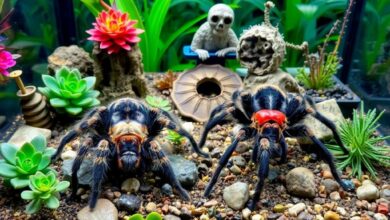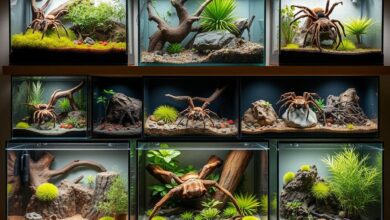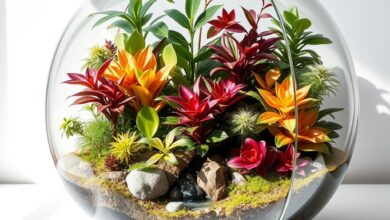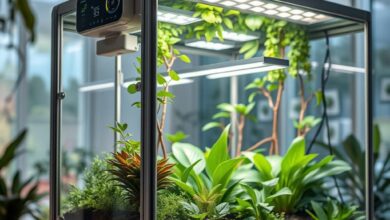The best substrates for different species of tarantulas
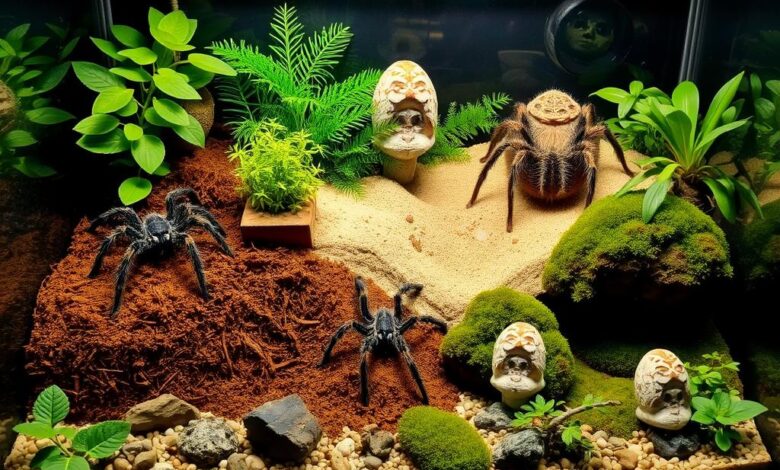
Choosing the right substrate is key for your tarantula’s health. Tarantulas need certain conditions to be happy and behave naturally. The right Terrarium Substrates, Bioactive Substrate Mixes, or Tropical Plant Soil can make a big difference. This article will look at the best substrates for different tarantulas, focusing on their unique needs.
Whether you have a Chaco Golden Knee Tarantula, a Pumpkin Patch Tarantula, or another type, the right Reptile Bedding and Moisture-Retaining Mediums are crucial. You can choose from Sphagnum Moss Substrates to Coconut Fiber Substrates. Each has its own benefits for your tarantula’s well-being.
Importance of Choosing the Right Substrate
Choosing the right substrate is key for your tarantula’s perfect habitat. The right substrate makes their home feel like their natural one, helping their health and happiness. It lets them act naturally, like digging and spinning webs, which they need for their well-being.
Replicating the Natural Environment
Tarantulas live in specific places, and the right substrate makes them feel secure. Naturalistic Vivariums are great for making a cozy home for your tarantula. They look like their natural home, which lowers stress and keeps them happy.
Promoting Natural Behaviors
The substrate you pick also helps your tarantula act naturally. Moisture-Retaining Mediums and Biodegradable Plant Litters are perfect for digging and web-spinning. These activities are key for their health.
Choosing the best substrate means your tarantula gets a great home. This helps them live well and supports their natural ways. It’s good for your pet and helps protect these amazing creatures in the wild.
Factors to Consider When Selecting a Substrate
Choosing the right substrate for your tarantula’s home is key. You need to think about how well it holds moisture and drains. The right choice can make a big difference in your tarantula’s health.
Moisture Retention
Tarantulas need certain humidity levels to do well. The substrate you pick helps keep the right moisture. Moisture-Retaining Mediums like sphagnum moss or coconut coir are great. They soak up and slowly release moisture, keeping the environment just right.
This stops your tarantula from getting too dry or too wet. It helps avoid breathing problems and stops mold and bacteria from growing.
Drainage Properties
Drainage is also crucial. You don’t want moisture building up and causing bad conditions. Drainage Layers like pebbles or leca can help. They make sure the substrate drains well and keeps air moving in the Naturalistic Vivarium.
Think about these things and pick a substrate that fits your tarantula’s needs. This way, you can give your pet a home that’s healthy and feels natural.
Sphagnum Moss Substrates
Creating the perfect home for your tarantula means choosing the right substrate. Sphagnum Moss Substrates are a top pick. They soak up moisture well, keeping your tarantula’s home just right. This moss also feels soft and natural under your tarantula’s feet, just like their wild home.
Sphagnum moss is not just good at holding moisture. It’s also biodegradable, which means it breaks down naturally. This helps keep smells down and keeps your tarantula’s home clean and healthy. It’s a great choice for keeping moisture in and for Biodegradable Plant Litters.
| Material Needed for a Moss Terrarium | Time Needed | Recommended Lighting |
|---|---|---|
| 1 hour, 30 minutes | LED terrarium lighting providing about 1000 lumens of daylight-colored temperatures for about 7 hours a day |
To keep the right humidity in a sphagnum moss terrarium, cover the vase with saran wrap but leave a small opening. Adding tiny pets like isopods, springtails, and millipedes can also help keep the environment balanced.
Sphagnum Moss Substrates are great for tarantulas because they hold moisture well and look natural. They also break down naturally, which is good for your tarantula’s home. By mimicking their wild home, you help your tarantula feel safe and behave naturally.
Coco Coir Substrates
Coco coir, or coconut fiber, is a great choice for tarantulas. It keeps moisture in and helps keep the right humidity levels. This is key for their health. Coco coir also lets tarantulas dig and make tunnels, just like in the wild.
Retaining Humidity Levels
Coco coir is great at keeping moisture in. Tarantulas need certain humidity to do well. Coco coir helps keep your terrarium moist, so it doesn’t dry out too fast.
Facilitating Burrowing Behavior
Tarantulas love to dig. Coco coir’s soft texture makes it easy for them to tunnel. This helps them stay happy and healthy. Coco coir also keeps the terrarium moist, making it perfect for your tarantula.
Terrarium Substrates
Choosing the right substrate is key for your tarantula’s home. Substrates for reptile and invertebrate tanks mimic nature and support natural behaviors. They help create a healthy environment.
Biodegradable and Eco-Friendly
Many substrates are biodegradable and eco-friendly. This makes them great for pet owners who care about the planet. They look good and are good for the earth.
Here are some top Terrarium Substrates:
- Coco Coir: Comes from coconut husks and is great for keeping moisture in and letting tarantulas dig.
- Sphagnum Moss: Keeps humidity up and looks natural, perfect for a cozy home.
- Orchid Bark: Light and breaks down, it’s great for tarantulas that live on the ground or in trees.
Using Biodegradable Plant Litters and Naturalistic Vivariums helps your tarantula thrive. It also reduces harm to the planet.
Vermiculite and Perlite Mixes
For tarantula lovers, vermiculite and perlite mixes are a top pick for terrarium substrate. These light materials are great at keeping the moisture level right, preventing too much water in the tank. They also help keep the right amount of moisture-retaining mediums, making a healthy space for your tarantula.
Vermiculite is a natural mineral that gets bigger when heated, becoming a light, porous material. It’s great at soaking up and holding onto moisture. Perlite is volcanic glass that also gets bigger when heated, making it light and porous like vermiculite. Together, they ensure good drainage and the right humidity for your tarantula.
- Vermiculite and perlite mixes are light and drain well, stopping too much moisture from building up.
- These materials keep the humidity just right, making a balanced and healthy space for your tarantula.
- Vermiculite is great at soaking up and keeping moisture, while perlite helps with drainage.
Adding a mix of vermiculite and perlite to your tarantula’s terrarium substrates makes a great environment. It’s natural-looking and meets your pet’s needs. This mix of drainage layers and moisture-retaining mediums is perfect for your tarantula’s health and happiness.
Cypress Mulch Substrates
Choosing the right substrate for your tarantula terrarium is crucial. Cypress mulch is a great choice because it’s natural and breaks down easily. It feels like the forest floor, letting your tarantula move and burrow comfortably. It also keeps the right amount of moisture in the terrarium.
Cypress mulch makes your terrarium look natural and beautiful. It has earthy colors and looks organic. This makes your Naturalistic Vivariums look better and makes caring for your tarantula more enjoyable.
Maintaining Optimal Moisture Levels
Cypress mulch is great for keeping the right amount of moisture in your terrarium. This is important for tarantulas that like a humid environment. It helps keep the terrarium from getting too dry or too wet, which is good for your pet’s health.
Cypress mulch also lets your tarantula act naturally. It’s textured and layered, so your tarantula can dig and feel safe. This is good for its well-being and helps it stay happy in its Biodegradable Plant Litters.
Using cypress mulch in your tarantula’s terrarium is a smart choice. It looks natural and meets your pet’s needs. This Terrarium Substrates option keeps the moisture right and lets your tarantula dig and burrow naturally. This ensures it lives well in its terrarium.
Repti-Bark and Orchid Bark Substrates
For a natural look in your tarantula’s home, consider repti-bark and orchid bark. These materials are not only good-looking but also keep the right moisture levels. They are great for Terrarium Substrates.
Repti-bark comes from cypress tree bark and is a favorite among tarantula keepers. It looks natural and has a rough texture, making it perfect for Naturalistic Vivariums. It also keeps moisture well, which is good for your tarantula’s humidity needs.
Orchid bark is another great choice. It comes from fir trees and looks similar to repti-bark. It’s great for Biodegradable Plant Litters and helps keep moisture levels right, just like repti-bark.
Both repti-bark and orchid bark are great for your tarantula’s health. They help create a natural home with Biodegradable Plant Litters. This makes your tarantula happy and healthy.
Potting Soil Mixes
Potting soil mixes work well for tarantula homes, but they might need extra stuff to be perfect. They have lots of nutrients and keep moisture well, making them great for Terrarium Substrates. But, you also need to add things like Moisture-Retaining Mediums and Drainage Layers for good drainage and air.
Supplementing with Additional Ingredients
Adding things like perlite, vermiculite, or a bit of sand makes a good potting soil mix. This mix helps with drainage and stops water from building up, which is bad for your tarantula’s health.
Try mixing different amounts of potting soil, Moisture-Retaining Mediums, and Drainage Layers to find the best mix for your tarantula. Watch how the mix works and change it if needed to keep the right moisture and air for your tarantula.
| Ingredient | Purpose | Recommended Ratio |
|---|---|---|
| Potting Soil | Nutrient-rich base | 50-70% |
| Perlite | Improve drainage and aeration | 20-30% |
| Vermiculite | Retain moisture and reduce compaction | 10-20% |
With the right mix of ingredients, you can make a potting soil mix that’s perfect for your tarantula. It will give your pet a great place to live.
Bioactive Substrate Mixes
For those who love tarantulas, Bioactive Substrate Mixes are a great choice. They mix coco coir, sphagnum moss, and other natural stuff with good bugs and detrivores (bugs that break down stuff).
Bioactive Substrate Mixes keep the right amount of moisture and nutrients in the tank. This makes a self-sustaining ecosystem. It’s like a mini-ecosystem that doesn’t need much work from you.
Cultivating a Thriving Ecosystem
A Bioactive Substrate Mix has materials that keep moisture in and let it drain well. This mix helps good bugs and small animals grow. They break down food and give nutrients back to the soil.
- Coco coir: Keeps humidity up and lets tarantulas dig
- Sphagnum moss: Keeps moisture high, perfect for humid-loving tarantulas
- Earthworm castings: Gives plants nutrients
- Activated carbon: Helps with air flow and bug activity
By making the right Bioactive Substrate Mix, you can make a Naturalistic Vivarium. This lets your tarantulas live in a natural setting. It’s good for them and easy to take care of.
Tropical Plant Soil Substrates
Choosing the right substrate is key for your tarantula’s home. Tropical plant soil mixes are great for tarantulas that love humid places. They mimic the moist, rich soil of tropical rainforests, where many tarantulas live.
Tropical Plant Soil keeps the right amount of moisture and gives your tarantula a natural home. It’s perfect for species like the Brachypelma hamorii that need more humidity.
Here are the perks of using Tropical Plant Soil in your tarantula’s terrarium:
- Keeps humidity just right, like their natural home
- Gives your tarantula a rich place to live and dig
- Encourages natural behavior in a more real setting
- Helps with water, preventing too much or too little moisture
When picking a tropical plant soil, go for a top-notch, drainy mix made for terrariums. Don’t use regular potting soil, as it might not keep moisture or drain well for tarantulas.
| Feature | Benefit |
|---|---|
| Moisture Retention | Keeps humidity right for tarantulas that need it |
| Nutrient-Rich Composition | Supports tarantulas in digging and exploring |
| Drainage Properties | Manages water well, avoiding too much or too little |
Using a quality Tropical Plant Soil in your tarantula’s space makes a lush, real home. It’s like their natural habitat, helping them stay healthy and happy.
Substrate Combinations for Different Species
Choosing the right substrate for your tarantula is key. Different tarantula species have different needs. It’s important to pick the best Terrarium Substrates for your pet. Mixing substrates like sphagnum moss, coco coir, and vermiculite can create a perfect environment for your tarantula.
Some tarantulas like a substrate that keeps moisture, like a mix of coco coir and sphagnum moss. This helps keep the right humidity. Others do well in a substrate with good drainage, such as vermiculite and orchid bark. This prevents waterlogging and ensures good air flow.
By knowing what your tarantula needs and trying out different substrates, you can make a natural and engaging home for your pet. This helps keep your tarantula healthy and happy.


